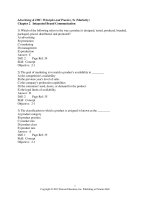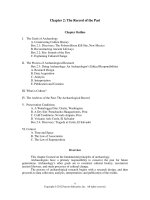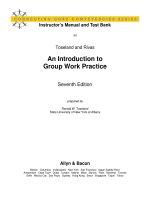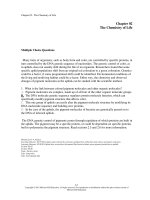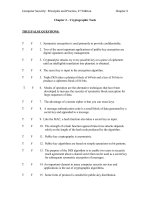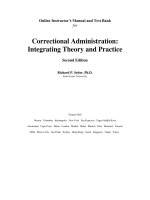Managing and organizations an introduction to theory and practice 3rd edition clegg test bank
Bạn đang xem bản rút gọn của tài liệu. Xem và tải ngay bản đầy đủ của tài liệu tại đây (196.01 KB, 13 trang )
MULTIPLE CHOICE BANK: Chapter Two – Managing Individuals
Below are a number of multiple-choice questions relevant to this chapter. Often,
there are 2 to 3 variations on the same questions. Each question has 4 options,
the correct answer is written in the final column. Some questions are very
simple while others are much more difficult: this should be taken into account
when setting quizzes or exams.
Example of possible instruction to students:
For each of the following questions read each question carefully then choose the
answer you believe is most correct:
Question and Options
#
Answ.
Much of the theorizing in psychology implicitly deals with
the question of what makes us who we are. Some argue
we are the way we are because of genetics, and others
say it is because of our learning and environment. This
debate is commonly known as the ____________
debate.
1
a
What is the term that reflects the belief that humans
2
naturally behave in hedonistic ways to ensure their genes
prevail over their competitors?
c
a. Nature versus Nurture
b. Biology versus Psychology
c. Who versus What
d. All of the above
a. Competition
b. Cooperation
c. The survival of the fittest
d. The survival of the fastest
_________ are desirable goals, varying in importance,
which serve as guiding principles in people’s lives?
a. Beliefs
b. Attitudes
c. Values
d. Assumptions
3
c
Which of the following is NOT characteristic of values?
4
d
5
a
6
c
7
b
8
b
a. Values serve as guiding principles in people lives
b. Values can create tension between subjective values and
societies values
c. Values are transituational
d. Values are easy to change to suit the situation
What is the ‘tension’ relating to values highlighted by
Aronson (1960) ___________?
a. Human are social animals living in a state of tension
between values associated with their individuality and
values associates with social conformance
b. Human are social animals that control tension because
they create values to establish norms of how to get along
as individuals and as a society
c. Human are social animals that use values as the building
blocks of their culture, and so use culture to control
tension
d. All of the above
Schwartz uses the term __________ to represent the
idea that irrespective of the situation in which one finds
themselves, their value priorities do not change.
a. Situational
b. Tensions
c. Transituational
d. Terminal
According to Schwartz if a person values personal
success, ambition, and capability above all else, that
person would give highest priority to the values of
________________.
a. Benevolence
b. Achievement
c. Power
d. Universalism
You tell a base jumper that there is a good chance he will
die the more times he jumps. He says “That just makes it
more exciting” and then he jumps. Schwartz would
argue that this person’s value priority is ____________.
a. Tradition
b. Stimulation
c. Benevolence
d. Hedonism
What does it mean to say values are ‘continuous’?
9
b
10
c
11
c
12
c
a. That our values go on forever
b. That values overlap
c. That values never change
d. All of the above
What is meant by the term ‘value priorities’?
a. That we only ever behave in ways consistent with those
values important to us
b. That we should constantly re-evaluate which values are
important to us
c. That our values are ordered in terms of their importance
to us in guiding us through life
d. That we change which values are important to us to suit
the situation we find ourselves in
Which one of the words below defines ‘the stable
patterns of behavior and internal states of mind that help
explain a person’s behavioral tendencies’?
a. Values
b. Behavior
c. Personality
d. Cognition
Your textbook identifies four general approaches to
making sense of personality. Which of the following is
not one of those?
a. Trait
b. Behavioral
c. Socio-cognitive
d. Postmodern
The belief that a person’s personality is the result of a
number of innate characteristics is typical of which
approach to personality?
13
c
14
c
15
d
16
d
17
c
a. Socio-cognitive
b. Psychoanalytic
c. Trait
d. Humanist
Which of the following is one of the most popular and
respected trait theories of personality developed by
McCrae and Costa (1986)?
a. The Myers Briggs Typology Indicator
b. The 16 Personality Factors
c. The Big Five Personality Factors
d. The Minnesota Multiphasic Personality Inventory
Which of the following is NOT a ‘Big Five’ personality
factor?
a. Emotional stability
b. Openness
c. Agreeableness
d. Introversion
According to the ‘Big Five’ personality factor theory, a
person who is characterized as calm, self satisfied, and
self-secure would be someone who scores highly on the
____________ factor.
a. Extraversion
b. Openness
c. Agreeableness
d. Emotional stability
The belief that a person’s personality is the result of their
learning, experience, and social relationships in life, is
typical of which approach to personality?
a. Humanist
b. Trait
c. Socio-cognitive
d. Psychoanalytic
What does Alfred Bandura mean by the term reciprocal
determinism?
18
b
19
b
20
b
21
d
22
d
a. Personality is already determined when we are born, and
so it shapes how we view and interact with our
environment
b. Personality is determined by our behavior, our thoughts
and feelings, in interaction with our environment
c. Personality is the result of the environment, and only the
environment can determine a persons personality
d. Both b and c
Which personality theory was Rotter (1966) integral in
developing?
a. The Big Five Personality Factor
b. Locus of control
c. Type A, Type B behavior
d. Psychoanalytic theory
The belief that events which happen in life are the result
of outside forces, even chance, is typical of individuals
with ______________.
a. Internal locus of control
b. External locus of control
c. Aggression
d. Hopes
What does research on locus of control show about
individual who are internals compared to externals?
a. They are higher achievers
b. They are more independent
c. They enjoy higher levels of psychological well-being and
cope better with stress
d. All of the above
The belief that a person’s personality is the result of
unconscious motives and desires, and defense
mechanisms aimed at controlling sexual anxieties and
the fear of death, is typical of which approach to
personality?
a. Humanist
b. Trait
c. Socio-cognitive
d. Psychoanalytic
_______________ is considered the ‘father’ of the
psychoanalytic approach to personality theory.
23
c
24
a
25
c
26
a
a. Alfred Bandura
b. Gordon Allport
c. Sigmund Freud
d. Dr Phil McGraw
Freud identified three levels in which our mind is
structured. The Id, Ego, and Superego. What role does
the Id play?
a. The id represents the unconscious and operates on the
‘pleasure principle’, it is driven by things like hunger,
sex, and aggression, it battles with the ego for control
b. The Id represents the control room of our personality,
it operates on the ‘reality principle’ and controls or
limits the unconscious, it battles with the ego for
control
c. The Id acts as a social and personal mentor as it forces
us to judge our feelings, thoughts, ideas and emotions,
it reconciles the ego and superego which are in
constant battle
d. All of the above
Which of the following is NOT one of Freud’s
psychosexual stages of development?
a. Genital
b. Anal
c. Nasal
d. Oral
Which one of the following describes an anally fixated
person?
a. Control oriented and stringent
b. Overeaters, and highly compulsive
c. Repressed, anxious and guilt ridden
d. All of the above
Which of the following describes an orally fixated
person?
27
b
28
c
29
c
30
a
a. Control oriented and stringent
b. Overeaters, and highly compulsive
c. Repressed, anxious and guilt ridden
d. All of the above
Which of the following describes a phallically fixated
person?
a. Control oriented and stringent
b. Overeaters, and highly compulsive
c. Repressed, anxious and guilt ridden
d. All of the above
You meet a man who built missiles designed to pierce the
enemy and destroy them. You just read the section on
Freud and tell the man the missile represents the penis
and the destruction it causes is a result of the man’s
sexual aggression and propensity to violence due to
feelings of sexual inadequacies. What defense
mechanism would you say the man is employing?
a. Reaction formation
b. Projection
c. Repression
d. Depression
You meet a young man who engages in violence against
men he thinks are homosexuals. You just read the
section on Freud and tell the man that he is resorting to
violence due to his confusion about his own sexuality.
Just before he hits you, what defense mechanism would
you say the young man is employing?
a. Reaction formation
b. Projection
c. Repression
d. Depression
You meet an office manager who treats you with deep
levels of distrust, and constantly questions your
competence and professionalism at work. You just read
the section on Freud and tell her she feels this way about
you because in reality she is incompetent and
unprofessional, and that she probably steals stationary.
Just before she fires you, what defense mechanism
would you say she is employing?
31
b
32
a
Use the statements below to complete the following: We 33
have an ‘idealized self’ – which represents what we strive
to be like - and an ‘actual self’ – which represents who
we feel we are. _____________
d
a. Reaction formation
b. Projection
c. Repression
d. Depression
The belief that all individuals are unique and each
person’s personality is the result of properties relative to
one’s self-concept is characteristic of which approach to
personality?
a. Humanist
b. Trait
c. Socio-cognitive
d. Psychoanalytic
a. We are said to have a positive self image if we act in ways
consistent with concepts of our ideal self
b. We are said to have a negative self image if we act in
ways inconsistent with our ideal self
c. We are said to have positive self image if we act in ways
consistent with our actual self
d. Both a and b
According to Carl Rogers (1967) our environment should
provide three basic conditions to enable self growth.
Which of the following is NOT one of those?
a. People must be authentic about their feelings
b. People must be accepting of oneself and other – even of
34
d
failures and shortcomings
c. People must practice empathy
d. People must believe in and practice their religion
The field of research and theory that seeks to understand
and foster civic virtues, social responsibility, altruism,
tolerance, happiness, authenticity and psychological well
being is know as ____________.
35
c
36
c
37
c
The term ____________ refers to feelings in response to, 38
or expectation of, an event or object
B
a. Positive power
b. Abnormal psychology
c. Positive Organizational Behavior
d. Organizational behavior
Which two psychologists are credited with the
development of positive psychology?
a. Katz and Khan
b. Frost and Dutton
c. Seligman and Csikszentmihalyi
d. Siegfried and Roy
Which one of the following people is credited with the
development of emotional intelligence?
a. George Bush
b. Stewart Clegg
c. Daniel Goleman
d. Sigmund Freud
a. Projection
b. Emotion
c. Moodiness
d. Hope
According to your text book, which of the following is
considered part of the definition of happiness?
a. Calmness
39
d
b. Joy
c. Contentment
d. All of the above
According to your text book, the difference between
emotions and moods is ___________.
40
b
41
d
42
a
43
b
44
A
a. Intensity of feeling
b. Duration of feeling
c. There is no difference
d. Joy
Which one of the following is NOT a ‘schema’ as
identified in your text book?
a. Person Schema
b. Script Schema
c. Social Schema
d. Rational Schema
The tendency to project emotions into the future and to
over generalize the intensity of the emotion to be felt is
known as _____________
a. Impact Bias
b. Anxiety Bias
c. Affective Bias
d. Social Bias
Which of the following is the definition of affective
forecasting offered in your text book
a. Basing your decision on future behavior on past emotional
experiences
b. Basing your decision on current behavior on expected
emotional experiences
c. Basing your past behaviors based on expected emotional
experiences
d. All of the above
Which of the following is NOT an example of focal error?
a. A man who has been reluctant to make an appointment to
see his doctor because he fears that the result will be bad,
finds out that he actually is gravely ill
b. A woman is disappointed by her wedding day, especially
after she had spent so much effort to organize an
elaborate wedding because she was determined to make it
the most special day of her life
c. A student feels relieved that the exam he was so worried
about actually was not that bad
d. The highly positive expectations that a manager had set
around completion of a project where not experienced,
even though the project was a success
SHORT ANSWER QUESTIONS
The section lists five (5) short answer questions with an outline of
what might be expected in a model answer. Students often will ask
“how long should the answer be?” Typically, answers should be
around a page in length.
Question 1:
List and describe Schwartz’s ten universal values. How
might our values priorities influence our behavior?
Answer Q1:
An acceptable answer will define values, and list and describe
the 10 values. The better student will show how different value
priorities might influence people to behave in different ways. A
superior answer will also discuss the ‘transituational’ and
‘continuous’ properties of values.
Question 2:
What are the big five personality factors, and what are
the characteristics of each of the factors?
Answer Q2:
This is a fairly simple question and so no student who has
attended classes and completed the prescribed reading should
have a problem writing a pass answer. Such an answer will
correctly identify and describe the big five (agreeableness,
openness, extraversion, emotional stability and
conscientiousness). The better student will describe the
characteristics of high and low scores on each dimension. Some
students may also discuss the big five within the context of traitbased theories. An exceptional answer will go beyond the
readings and will demonstrate wider reading and research.
Question 3:
Compare and contrast the ‘psychoanalytic’ and ‘humanist
self psychology’ approaches to personality. What are
some strengths and weaknesses to both approaches?
Why should a manager have knowledge about such
approaches to personality?
Answer Q3:
A good answer will show a good understanding about the origins
and major assumptions of the psychoanalytic approach (i.e.
Freud’s notion of id, ego, superego and the psychosexual stages
of development); and of the humanist approach (essentially that
the humanist approach seeks to develop positive self-concepts,
rather than delving into the unconscious desires and lusts they
are about bridging the gap between the ideal self and the actual
self). A better student might notice that both are about
suppressing negative feelings associated with who they want to
be, and who they really are. An excellent answer will creatively
and reflectively describe and justify why personality theory –
even Freud’s – can help people manage people better (extra
marks should be awarded for students that answer this part of
the question beyond what is already stated in the textbook).
Question 5:
What are emotions and can they be managed
Answer Q5:
A good answer will define emotions, and then discuss emotional
intelligence as a form of emotional management. The better
answers will provide clear examples of emotions at work, and
managerial attempts to control them will be discussed from a
critical perspective.
Question 6
Describe the main features of Affective Forecasting and
provide some concrete examples of focal errors.
Answer Q6
An ideal answer will list all common elements of affective
forecasting, such as the positive/negative feelings attached to
the prospect of the completion or realization of a future event,
but which end up counter to those emotions upon actual
completion or realization of that event. A good answer will also
mention some of the cultural differences in affective forecasting.
Examples can include the hype surrounding completion of tasks,
the marketing of products and the actual user experience, and
so on.
ESSAY QUESTION
The section is comprised of three (3) essay questions. The answers
should reflect the students’ knowledge of the topic area learned in
class, their readings, and through other sources. The good student will
demonstrate their ability to reflect upon, and analyze, key ideas or
issues. These questions can be incorporated into a mid term or end of
semester exam. Conversely, the questions can be assigned as a takehome essay assignment. The length of the expected answer will vary
accordingly, but typically expect two to three pages in an exam setting,
and request 2,000 words or more in a take home essay assignment.
What influence has the field of positive psychology had upon
organizational behavior? How does it differ to current
applications of psychology to management and organization
theory and research?
Read the following statement:
“Without happiness, no person would be able to function adequately
within organization”
Do you agree or disagree with this statement? Be sure to justify
your answer with clear examples and arguments, backed by
adequate research on the topic.
Why is an understanding of perception critical to good
management?
INTEGRATED ESSAY QUESTION
This section is comprised of one (1) integrated question which requires
the student to demonstrate their reading and understanding of this
chapter and an ability to incorporate elements from other sections of
this textbook. Ideally, this question is best administered as a major
take home assignment. The minimum length would be 3,000 words.
How might total institutions foster and institutionalize negative
emotions at work through structure, communication, and strategy?
Drawing upon principles from positive psychology and positive power,
what tools or strategies do you recommend leaders use to detoxify
total institutions both in the way they communicate and strategize?
